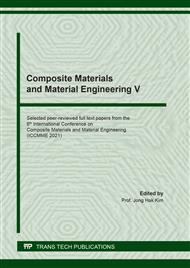[1]
J. J. Beaudoin: Handbook of fiber-reinforced concrete: principles properties, developments and applications (Noyes Publications, Park Ridge, N.J., U.S.A, 1990).
Google Scholar
[2]
J. Bijen: Improved mechanical properties of glass fibre reinforced cement by polymer modification, Cement and Concrete Composites Vol. 12 (1990), p.95–101.
DOI: 10.1016/0958-9465(90)90046-z
Google Scholar
[3]
Pu-Woei Chen and D. D. L. Chung: Comparative Study of Concretes Reinforced with Carbon, Polyethylene, and Steel Fibers and Their Improvement by Latex Addition, ACI Materials Journal Vol. 93 (1996).
DOI: 10.14359/1411
Google Scholar
[4]
J. B. Kardon: Polymer-Modified Concrete: Review, Journal of Materials in Civil Engineering Vol. 9 (1997), p.85–92.
Google Scholar
[5]
Y. Ohama: Polymer-based admixtures, Cement and Concrete Composites Vol. 20 (1998), p.189–212.
DOI: 10.1016/s0958-9465(97)00065-6
Google Scholar
[6]
Y. Ohama: Concrete-Polymer Composites – The Past, Present and Future, KEM 466 (2011), p.1–14.
DOI: 10.4028/www.scientific.net/kem.466.1
Google Scholar
[7]
B. Chen and J. Liu: Mechanical properties of polymer-modified concretes containing expanded polystyrene beads, Construction and Building Materials Vol. 21 (2007), p.7–11.
DOI: 10.1016/j.conbuildmat.2005.08.001
Google Scholar
[8]
Issa Mohsen A., Alhassan Mohammad A. and Shabila Hameed: High-Performance Plain and Fibrous Latex-Modified and Microsilica Concrete Overlays, Journal of Materials in Civil Engineering Vol. 20 (2008), p.742–753.
DOI: 10.1061/(asce)0899-1561(2008)20:12(742)
Google Scholar
[9]
G. Li, X. Zhao, C. Rong and Z. Wang: Properties of polymer modified steel fiber-reinforced cement concretes, Construction and Building Materials Vol. 24 (2010), p.1201–1206.
DOI: 10.1016/j.conbuildmat.2009.12.020
Google Scholar
[10]
B. Huang, H. Wu, X. Shu and E. G. Burdette: Laboratory evaluation of permeability and strength of polymer-modified pervious concrete, Construction and Building Materials Vol. 24 (2010), p.818–823.
DOI: 10.1016/j.conbuildmat.2009.10.025
Google Scholar
[11]
Y. Lin, J. N. Karadelis and Y. Xu: A new mix design method for steel fibre-reinforced, roller compacted and polymer modified bonded concrete overlays, Construction and Building Materials Vol. 48 (2013), p.333–341.
DOI: 10.1016/j.conbuildmat.2013.06.020
Google Scholar
[12]
S. Chakraborty, S. P. Kundu, A. Roy, B. Adhikari and S. B. Majumder: Polymer modified jute fibre as reinforcing agent controlling the physical and mechanical characteristics of cement mortar, Construction and Building Materials Vol. 49 (2013), p.214–222.
DOI: 10.1016/j.conbuildmat.2013.08.025
Google Scholar
[13]
F. Xu, M. Zhou, J. Chen and S. Ruan: Mechanical performance evaluation of polyester fiber and SBR latex compound-modified cement concrete road overlay material, Construction and Building Materials Vol. 63 (2014), p.142–149.
DOI: 10.1016/j.conbuildmat.2014.04.054
Google Scholar
[14]
J. N. Karadelis and Y. Lin: Flexural strengths and fibre efficiency of steel-fibre-reinforced, roller-compacted, polymer modified concrete, Construction and Building Materials Vol. 93 (2015), p.498–505.
DOI: 10.1016/j.conbuildmat.2015.04.059
Google Scholar
[15]
T. Meraj, A. K. Pandey and B. K. Rao: Flexural behaviour of latex modified steel fiber reinforced concrete, Indian J. Eng. Mater. Sci. Vol. 8 (2014).
Google Scholar
[16]
U. Kalawane, Y. Ghugal and A. Dahake: Shear strength of polymer modified steel fiber reinforced concrete, The Indian Concrete Journal Vol. 90 (2016), p.54–63.
Google Scholar
[17]
U. Kalawane, Y. Ghugal and A. Dahake: Toughness of Polymer Modified Steel Fiber Reinforced Concrete, Open Journal of Civil Engineering Vol. 6 (2016), p.8–18.
DOI: 10.4236/ojce.2016.61002
Google Scholar
[18]
F. Xu, C. Peng, J. Zhu and J. Chen: Design and evaluation of polyester fiber and SBR latex compound-modified perlite mortar with rubber powder, Construction and Building Materials Vol. 127 (2016), p.751–761.
DOI: 10.1016/j.conbuildmat.2016.10.060
Google Scholar
[19]
M. Wang, R. Wang, H. Yao, S. Farhan, S. Zheng, Z. Wang, C. Du and H. Jiang: Research on the mechanism of polymer latex modified cement, Construction and Building Materials Vol. 111 (2016), p.710–718.
DOI: 10.1016/j.conbuildmat.2016.02.117
Google Scholar
[20]
Y. Ghugal: Performance of polymer modified polypropylene fiber reinforced concrete with low fiber volume fractions, The Indian Concrete Journal Vol. 90 (2016), p.44–52.
Google Scholar
[21]
Bureau of Indian Standards, IS 12269 (2013) : Ordinary Portland Cement, 53 Grade Specifications, BIS New Delhi (2013).
Google Scholar
[22]
Bureau of Indian Standards, IS 383 (1970): Specification for coarse and fine aggregates from natural sources for concrete, BIS New Delhi (1970).
Google Scholar
[23]
A01 Committee, Specification for Steel Fibers for Fiber-Reinforced Concrete (ASTM International, 1996).
Google Scholar
[24]
Bureau of Indian Standards, IS 10262 (2009) : Guidelines for concrete mix design proportioning, BIS New Delhi (2009).
Google Scholar
[25]
Bureau of Indian Standards, IS 516 (1959): Method of Tests for Strength of Concrete, BIS New Delhi (1959) 30.
Google Scholar
[26]
C09 Committee, Test Method for Flexural Performance of Fiber-Reinforced Concrete (Using Beam With Third-Point Loading) (ASTM International, n.d.).
DOI: 10.1520/c1609_c1609m-05
Google Scholar
[27]
A. M. Neville and A. M. Neville: Properties of Concrete (Pearson, 2011).
Google Scholar
[28]
Bureau of Indian Standards, IS 456 (2000): Plain and Reinforced concrete - Code of practice, BIS New Delhi (2016) 114.
Google Scholar
[29]
British Standard Institution, London, BS 8110 (1985): Structural use of concrete, Part 2: Code of practice for special circumstances, (1985).
Google Scholar
[30]
D. C. Teychenné, L. J. Parrott and C. D. Pomeroy: The Estimation of the Elastic Modulus of Concrete for the Design of Structures (Building Research Establishment, Garston, UK, 1993).
Google Scholar
[31]
S. W. Nakin Suksawang and Ahmed Alsabbagh: Evaluation of Elastic Modulus of Fiber-Reinforced Concrete, ACI Materials Journal Vol. 115 (2018).
DOI: 10.14359/51701920
Google Scholar
[32]
C09 Committee, Test Method for Flexural Toughness and First-Crack Strength of Fiber-Reinforced Concrete (Using Beam With Third-Point Loading) (ASTM International, n.d.).
DOI: 10.1520/c1018-97
Google Scholar
[33]
V. S. Gopalaratnam and S. P. Shah: Fracture Toughness of Fiber Reinforced Concrete, ACI Materials Journal Vo. 88 (1991).
Google Scholar
[34]
D. J. Hannant: Fibre cements and fibre concretes (Wiley, Chichester ; New York, 1978).
Google Scholar
[35]
J. C. Halpin and S. W. Tsai: Effects of environmental factors on composite materials (1969).
Google Scholar
[36]
H. L. Cox: The elasticity and strength of paper and other fibrous materials, British Journal of Applied Physics Vol. 3 (1952), p.72–79.
DOI: 10.1088/0508-3443/3/3/302
Google Scholar
[37]
H. G. Allen: The strength of thin composites of finite width, with brittle matrices and random discontinuous reinforcing fibres, Journal of Physics D: Applied Physics Vol. 5 (1972), p.331–343.
DOI: 10.1088/0022-3727/5/2/316
Google Scholar


